|
|
|
Seymour CHWAST
Affiche Seymour Chwast : An American in Paris. Barklays of Broadway, Showboat, Easter Parade, Brodway Melody of 1936. Gigi, Gabin in the Sky, Ziegfeld Folies. A tribute to Arthur Freed. June 20 -August 20, Gallery of Modern Art, 2 Columbus Circle, N.Y. Raymond Rohauer, Film Curator and Program Director.
New York, Personality Posters Inc, 1967, 75x101,50 cm, S. Chwast (New York, 1931 - ...), scénariste et dessinateur américain, fondateur avec Milton Glaser du "Push Pin studio" dans les années 1960. Petites déchirures marginales et petits trous dans le fond jaune. Quelques plis (particulièrement visibles sur les photos). Imprimé en jaune, rose, orange et bleu sur vélin gauffré.
Référence libraire : 81316
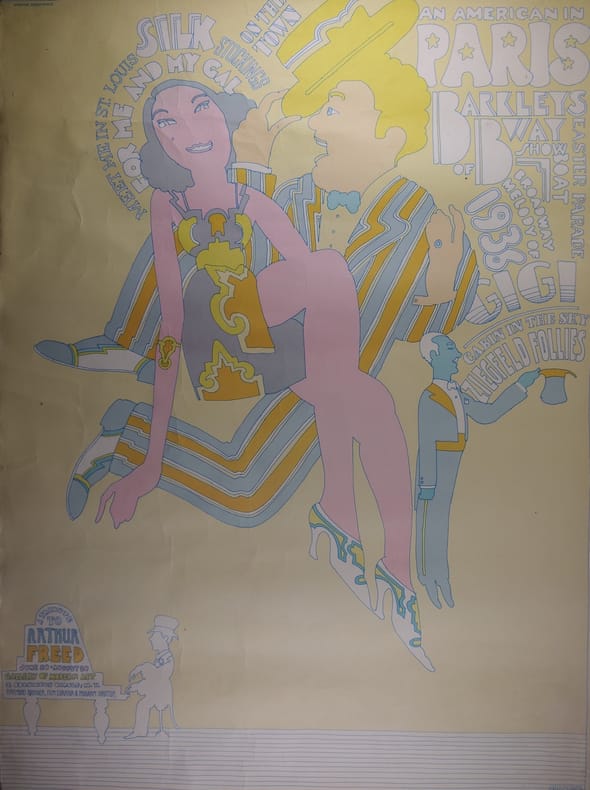
|
|
|
Sfar Joann:
La java bleue.
Affiche au format 50 x 70 cm. A l'état de neuf.
Référence libraire : 2843
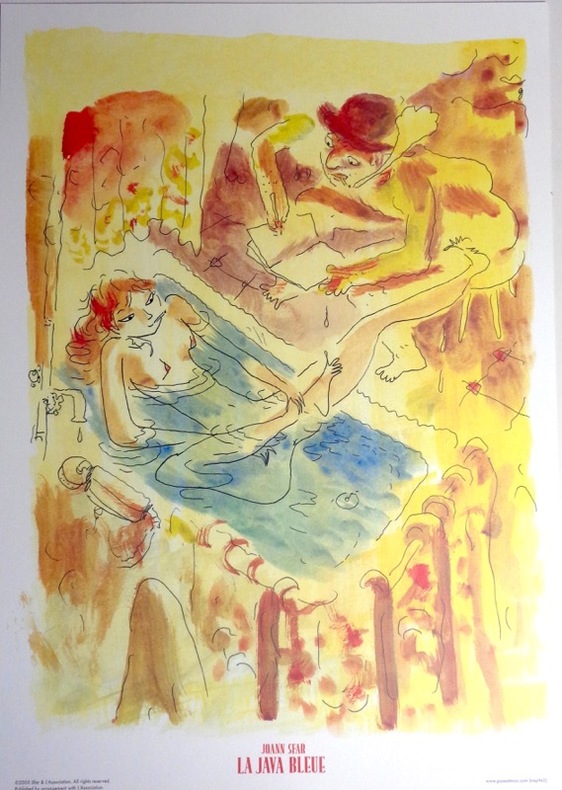
|
|
|
Shahn, Ben; Kao, Deborah Martin; Katzman, Laura; Webster, Jenna
Ben Shahn's New York : The Photography of Modern Times
A clean, unmarked book with a tight binding. Light wear, small tears and spots to cover. 9"w x 10"h. 340 pages.

|
|
|
Shelton Gilbert:
[Corrida].
Affiche au format 40 x 60, à l'état de neuf.
Référence libraire : 3077
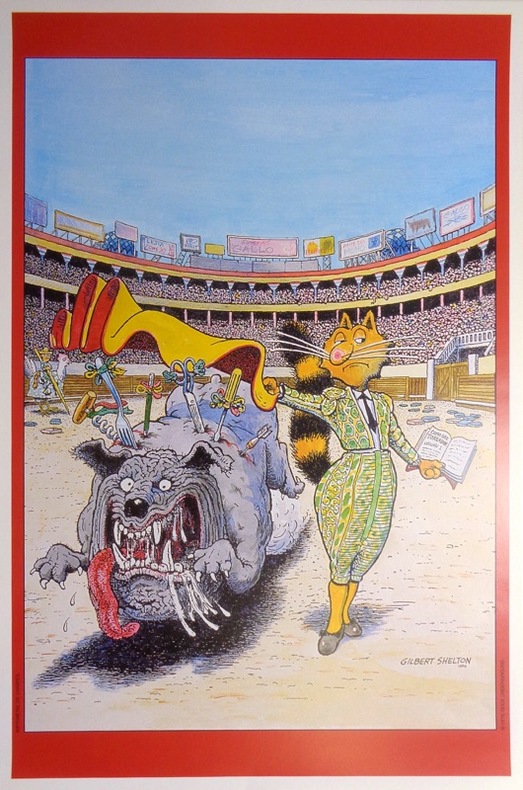
|
|
|
Shelton Gilbert:
[Embouteillage].
Affiche au format 40 x 60 cm., à l'état de neuf.
Référence libraire : 3080
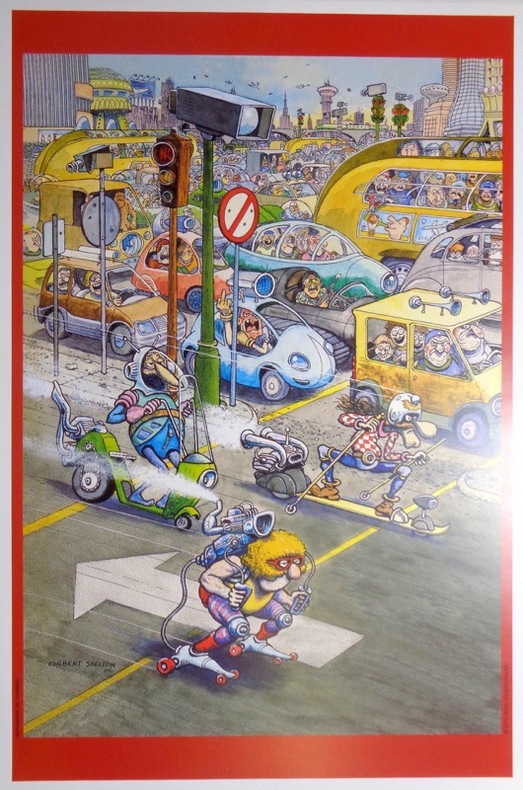
|
|
|
Shelton Gilbert:
France 1998. Official Freak Brothers poster.
Affiche au format 40 x 61 cm., à l'état de neuf.
Référence libraire : 3079
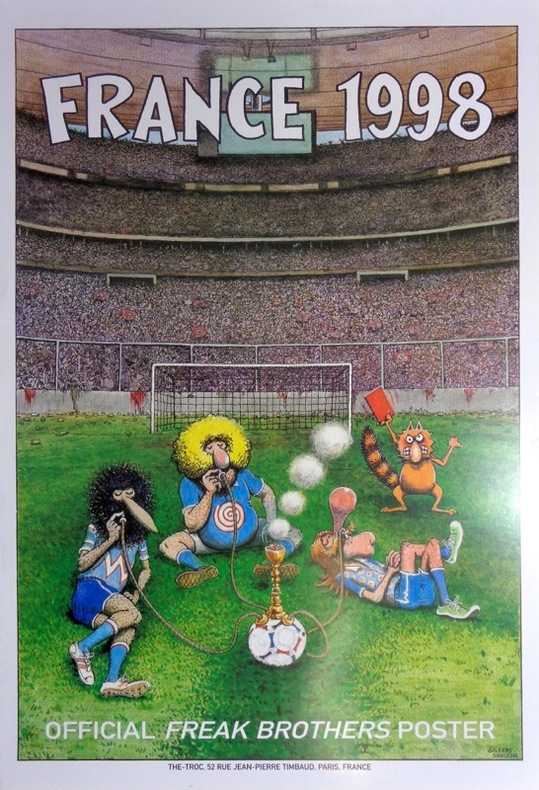
|
|
|
Shelton Gilbert:
France 1998. Official Freak Brothers poster.
Reproduction sur papier fort, au format 20 x 28 cm. et à l'état de neuf.
Référence libraire : 12530
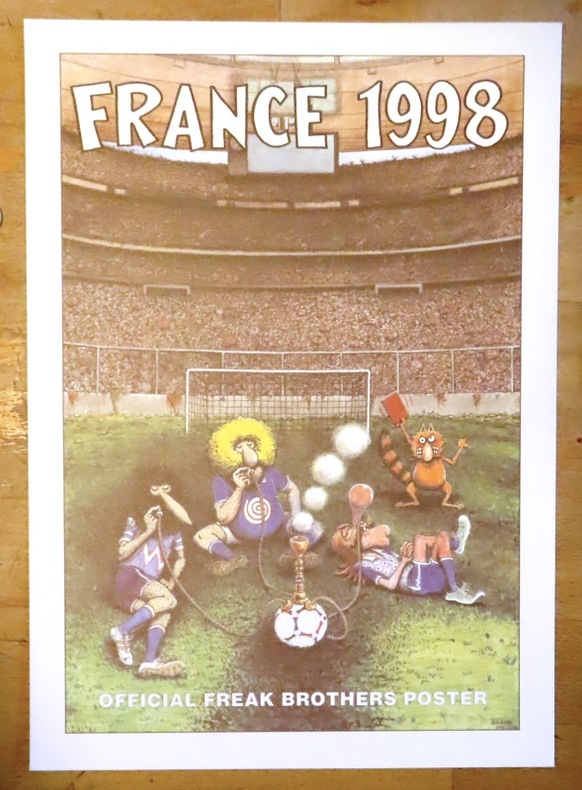
|
|
|
Shelton Gilbert:
Freewheeling' Franklin dit : "La dope fait mieux passer les périodes sans argent que l'argent ne fait passer les périodes sans dope".
Affiche au format 41 60 cm., à l'état de neuf. 2 exemplaires pour 40 francs suisses (prendre contact si vous êtes intéressé. . . )
Référence libraire : 2881
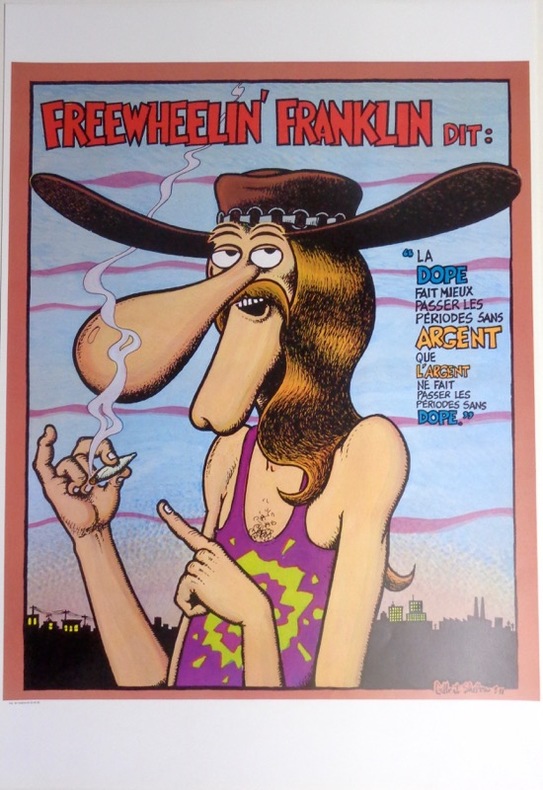
|
|
|
Shelton Gilbert:
Les fabuleux Freak Brothers.
Galerie Thé-Troc. Affiche au format 30 x 42 cm., à l'état de neuf.
Référence libraire : 3081
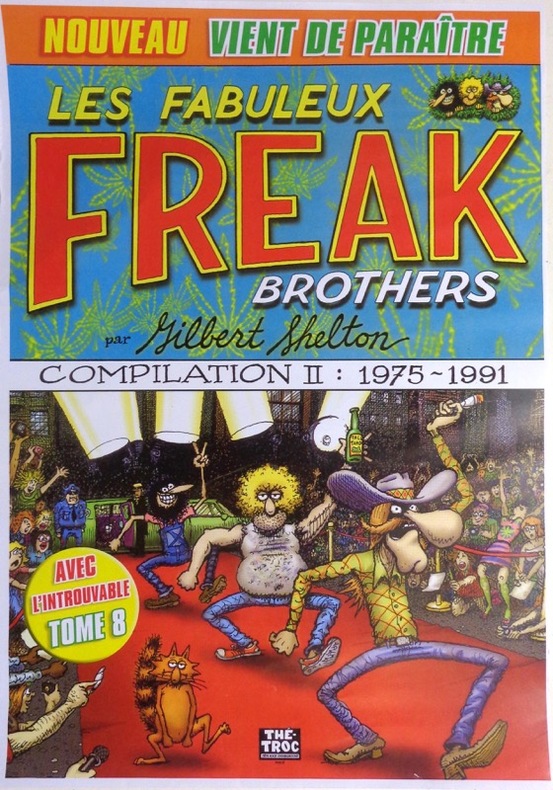
|
|
|
Shelton Gilbert:
Starry night in Amsterdam.
Galerie Thé-Troc. Affiche au format 30 x 43 cm., à l'état de neuf.
Référence libraire : 3076
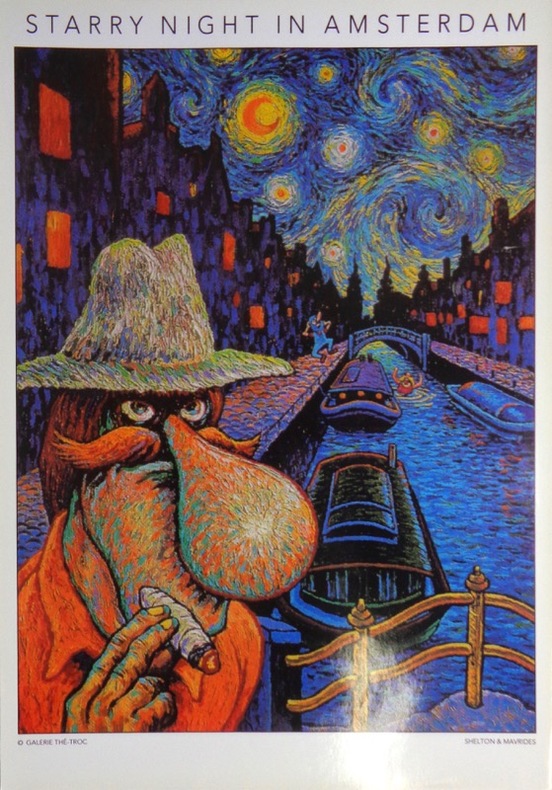
|
|
|
Shelton Gilbert:
The fabulous furry Freak Brothers.
Reproduction sur papier fort, au format 20 x 28 cm. et à l'état de neuf.
Référence libraire : 12531
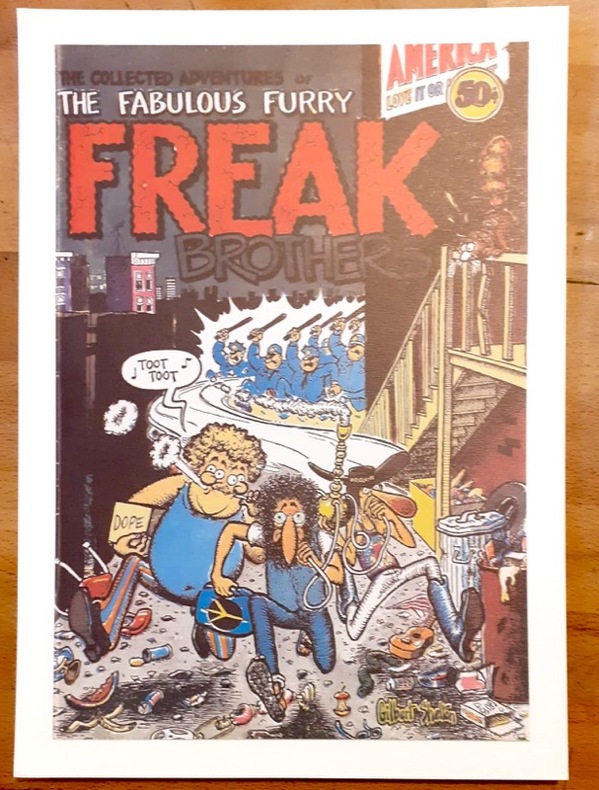
|
|
|
SHELL POSTERS. David Bernstein.
The Shell Poster Book. With an introduction by David Bernstein.
Hamish Hamilton London 1992. First edition. Landscape 4to. Pictorial glossy card wrappers. A two-page introduction precedes ninety-two full-page colour reproductions of Shell advertising posters designed by John Banting Vanessa Bell E.McKnight Kauffer Barnett Freedman Graham Sutherland Paul Nash Rosemary and Clifford Ellis Lord Berners Edward Ardizzone Ben Nicholson Charles Mozley &c. A little light surface marking to the wrappers and a former owner name discreetly inked to the inner wrapper. Errata slip laid-in as issued. A very good copy. 1st Edition. Soft cover. Very Good. Hamish Hamilton, London Paperback
Référence libraire : ARC91663

|
|
|
SHIRLEY McLAINE - BILL PAXTON - JULIETTE LEWIS
AFFICHE DE CINEMA - ETOILE DU SOIR THE EVENING STAR
ROBERT HARLING. Non daté. In-12. Broché. Bon état, Couv. convenable, Dos satisfaisant, Intérieur frais. Affiche de cinéma 120 cm x160 cm. Présenté par Paramount Pictures et Rysher Entertainment.. . . . Classification : 0-Affiches Cinéma
Référence libraire : R100000083
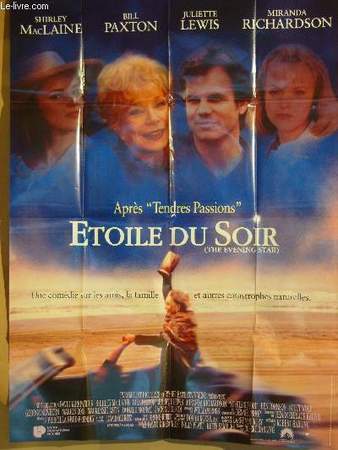
|
|
|
Shirow Masamune:
Appleseed.
Affiche au format 68 x 98cm., en très bel état.
Référence libraire : 3524
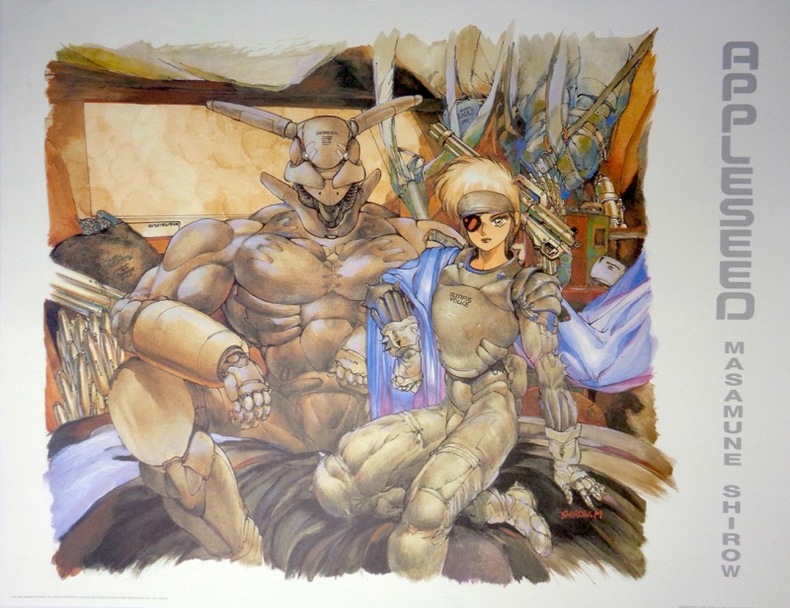
|
|
|
Shirow Masamune:
Compass.
Affiche au format 68 x 98cm., en très bel état.
Référence libraire : 3525
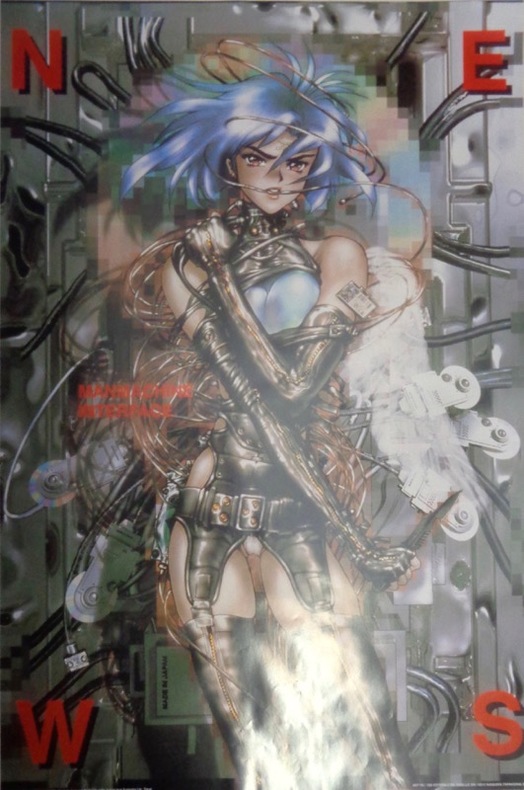
|
|
|
Sierra, Santiago
Haus im Schlamm. [Plakat] Kestner-Gesellschaft Hannover. 11. Februar - 10. April 2005.
Hannover., Kestner Gesellschaft., 2005. 84 x 59 cm., Umschlag Sehr gutes Exemplar.
Référence libraire : 33928AB

|
|
|
Signac.
Signac. Affiche éditée à l'occasion de l'exposition "Les Plaisirs de L'été" à la Galerie de Paris du 16 juin au 24 juillet 1965.
Une affiche de 50 x 70 cm; lithographie de Mourlot.
Référence libraire : 15785
|
|
|
Signac.
Signac. Affiche éditée à l'occasion de l'exposition "Les Plaisirs de L'été" à la Galerie de Paris du 16 juin au 24 juillet 1965.
Une affiche de 50 x 70 cm; lithographie de Mourlot. Manqueà l'angle inférieur droit. Sinon bel état. Voir photo.
|
|
|
SIGNORINA, 10.000.
Locandina pubblicitaria per la commedia ungherese diretta da Béla Gaàl.
Manifesto litografico originale cm 204x98 intelato, perfettamente conservato.. .

|
|
|
SIGNORINA, 10.000.
Locandina pubblicitaria per la commedia ungherese diretta da Béla Gaàl.
Manifesto litografico originale cm 204x98 intelato, perfettamente conservato.. .
|
|
|
Silvy H.:
[Navire].
Sérigraphie au format 24,5 x 32.
Référence libraire : 15485
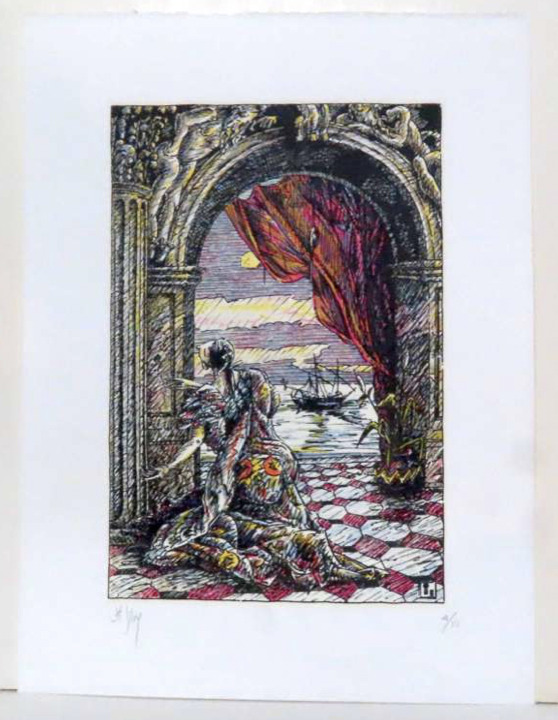
|
|
|
Simon (Tschopp):
[Dodgers].
Sierre, Impression Rangé. Sérigraphie au format 70 x 50 cm., à l'état de neuf.
Référence libraire : 3415
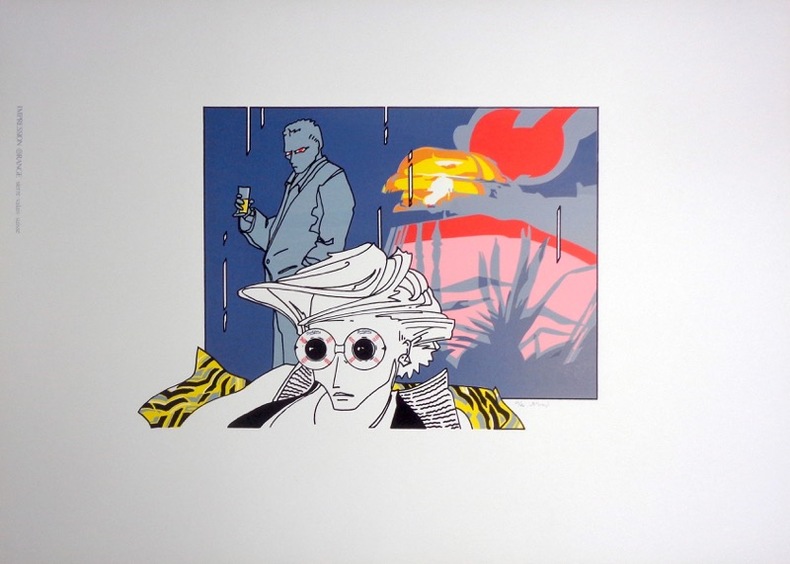
|
|
|
Simon (Tschopp):
[Sans titre].
Sierre, Impression Rangé. Sérigraphie au format 70 x 50 cm., légèrement salie, infime trace de pli.
Référence libraire : 3637
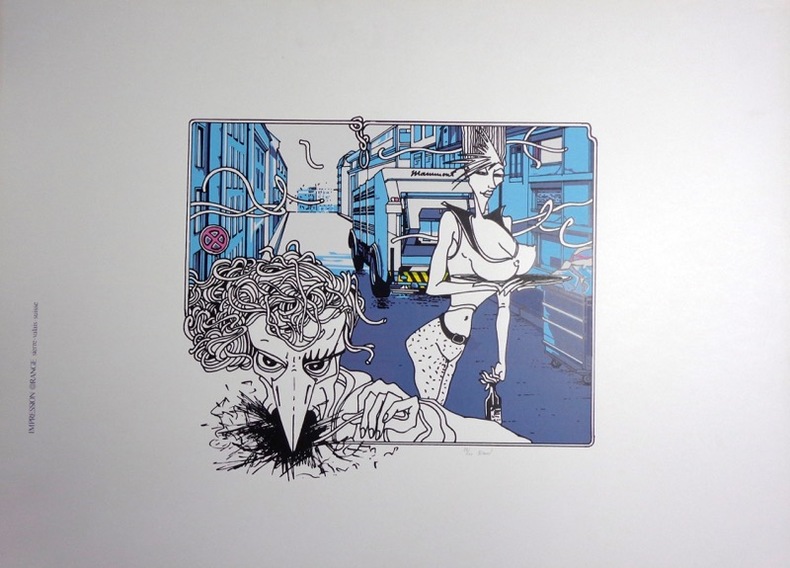
|
|
|
Simon:
Bankman - La tirelire volante vole au secours des petits épargnants.
Sérigraphie Humbert-Droz, 1991. Affiche sérigraphiée grand format, faisant partie d'une série réalisée par des dessinateurs du cru (toutes au format d'environ 70 x 100 cm.) célébrant à leur manière le 700e anniversaire de la Confédération suisse (1991, vous en souvient-il?).
Référence libraire : 3202
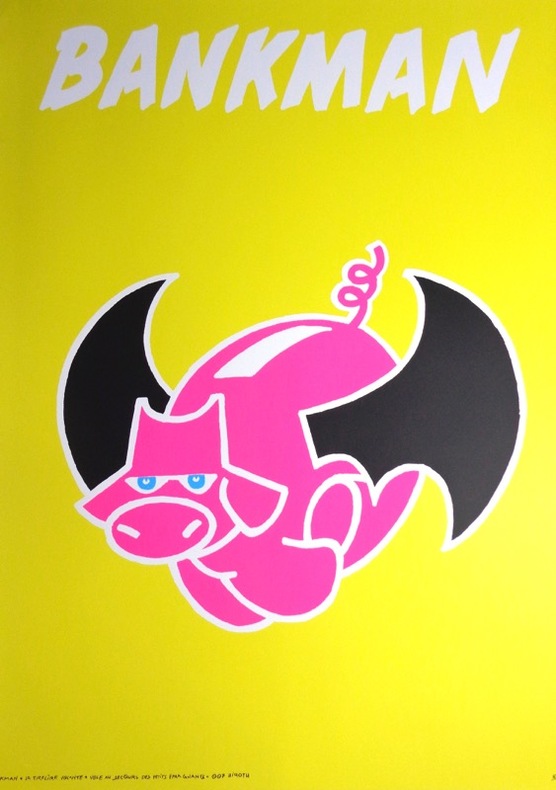
|
|
|
Simon Michel:
Exposition Michel Simon. Casino du Rivage Vevey.
Cinémathèque suisse, Albin Uldry Sérigraphie, 1982. Affiche au format 70 x 100 cm. Trous de punaises aux coins, a été pliée en 6.
Référence libraire : 5089
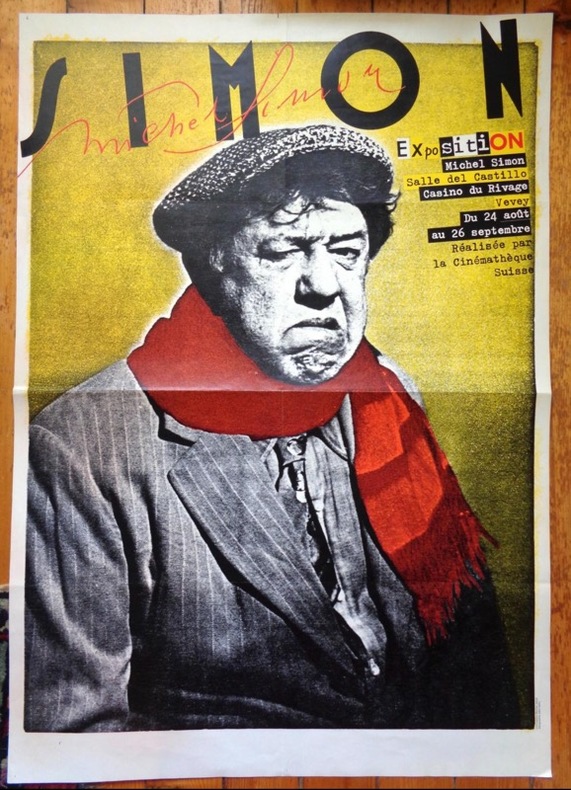
|
|
|
Simon-Auguste.
Simon-Auguste. Affiche éditée à l'occasion de l'exposition à la Galerie de Presbourg du 8 novembre au 8 décembre 1960.
Paris à la Galerie 1960 1 Une affiche de dimensions 51 x 72 cm; impression offset des Imprimeries Artistiques.
Référence libraire : 15786
|
|
|
SIMEON
L'ondulation permanente Eugène (Publicité, La Gazette du Bon ton, 1920)
- Lucien Vogel éditeur, Paris 1920, 18x24cm, une feuille. - Estampe originale en couleur faisant la publicité de la boutique Verlaine, tirée sur papier vergé. Deux vignettes publicitaires au spine sur Valaze et les produits du Dr Dys. Gravure originale réalisée pour l'illustration de La Gazette du bon ton, l'une des plus belles et des plus influentes revues de mode du XXème siècle, célébrant le talent des créateurs et des artistes français en plein essor de l'art déco. Célèbre revue de mode fondée en 1912 par Lucien Vogel, La Gazette du bon ton a paru jusqu'en 1925 avec une interruption durant la Guerre de 1915 à 1920, pour cause de mobilisation de son rédacteur en chef. Elle se constitue de 69 livraisons tirées à seulement 2000 exemplaires et est illustrée notamment de 573 planches en couleurs et de 148 croquis représentant des modèles de grands couturiers. Dès leur parution, ces luxueuses publications « s'adressent aux bibliophiles et aux mondains esthètes » (Françoise Tétart-Vittu « La Gazette du bon ton » in Dictionnaire de la mode, 2016). Imprimées sur beau papier vergé, elles utilisent une police typographique spécialement créée pour la revue par Georges Peignot, le caractère Cochin, repris en 1946 par Christian Dior. Les estampes sont réalisées grâce à la technique du pochoir métallique, rehaussées en couleurs et pour certaines soulignées à l'or ou au palladium. L'aventure commence en 1912 lorsque Lucien Vogel, homme du monde et de la mode - il a déjà participé à la revue Femina - décide de fonder avec sa femme Cosette de Brunhoff (sur de Jean, le père de Babar) la Gazette du bon ton dont le sous-titre est alors « Art, modes et frivolités ». Georges Charensol rapporte les propos du rédacteur en chef : « En 1910, observe-t-il, il n'existait aucun journal de mode véritablement artistique et représentatif de l'esprit de son époque. Je songeais donc à faire un magazine de luxe avec des artistes véritablement modernes [...] J'étais certain du succès car pour la mode aucun pays ne peut rivaliser avec la France. » (« Un grand éditeur d'art. Lucien Vogel » in Les Nouvelles littéraires, n°133, mai 1925). Le succès de la revue est immédiat, non seulement en France, mais aussi aux Etats-Unis et en Amérique du Sud. À l'origine, Vogel réunit donc un groupe de sept artistes : André-Édouard Marty et Pierre Brissaud, suivis de Georges Lepape et Dammicourt ; et enfin ses amis de l'École des beaux-arts que sont George Barbier, Bernard Boutet de Monvel, ou Charles Martin. D'autres talents viennent rapidement rejoindre l'équipée : Guy Arnoux, Léon Bakst, Benito, Boutet de Monvel, Umberto Brunelleschi, Chas Laborde, Jean-Gabriel Domergue, Raoul Dufy, Édouard Halouze, Alexandre Iacovleff, Jean Émile Laboureur, Charles Loupot, Charles Martin, Maggie Salcedo. Ces artistes, inconnus pour la plupart lorsque Lucien Vogel fait appel à eux, deviendront par la suite des figures artistiques emblématiques et recherchées. Ce sont ces mêmes illustrateurs qui réalisent les dessins des publicités de la Gazette. Les planches mettent en lumière et subliment les robes de sept créateurs de l'époque : Lanvin, Doeuillet, Paquin, Poiret, Worth, Vionnet et Doucet. Les couturiers fournissent pour chaque numéro des modèles exclusifs. Néanmoins, certaines des illustrations ne figurent aucun modèle réel, mais seulement l'idée que l'illustrateur se fait de la mode du jour. La Gazette du bon ton est une étape décisive dans l'histoire de la mode. Alliant l'exigence esthétique et l'unité plastique, elle réunit pour la première fois les grands talents du monde des arts, des lettres et de la mode et impose, par cette alchimie, une toute nouvelle image de la femme, élancée, indépendante et audacieuse, également portée par la nouvelle génération de couturiers Coco Chanel, Jean Patou, Marcel Rochas... Reprise en 1920 par Condé Montrose Nast, la Gazette du bon ton inspirera largement la nouvelle composition et les choix esthétiques du « petit journal mourant » que Nast ava

|
|
|
SIMEON
Le Retour des autans. Tailleur et Robe d'après-midi, de Doeuillet. (La Gazette du Bon ton, n°7 - Planche 55 )
- Lucien Vogel éditeur, Paris [circa 1920], 19,5x25cm, une feuille. - Original color print, printed on vergé paper, non signed. An original print used to illustrate the Gazette du bon ton, one of the most attractive and influential 20th century fashion magazines, featuring the talents of French artists and other contributors from the burgeoning Art Deco movement. A celebrated fashion magazine established in 1912 by Lucien Vogel, La Gazette du bon ton appeared until 1925, with a hiatus from 1915 to 1920 due to the war (the editor-in-chief having been called up for service). It consisted of 69 issues printed in only 2,000 copies each and notably illustrated with 573 color plates and 148 sketches of the models of the great designers. Right from the start, this sumptuous publication "was aimed at bibliophiles and fashionable society," (Françoise Tétart-Vittu, "La Gazette du bon ton", in Dictionnaire de la mode, 2016) and was printed on fine vergé paper using a type cut specially for the magazine by Georges Peignot, known as Cochin, later used (in 1946) by Christian Dior. The prints were made using stencils, heightened in colors, some highlighted in gold or palladium. The story began in 1912, when Lucien Vogel, a man of the world involved in fashion (he had already been part of the fashion magazine Femina) decided, with his wife Cosette de Brunhoff - the sister of Jean, creator of Babar - to set up the Gazette du bon ton, subtitled at the time: "Art, fashion, frivolities." Georges Charensol noted the reasoning of the editor-in-chief: "'In 1910,' he observed, 'there was no really artistic fashion magazine, nothing representative of the spirit of the time. My dream was therefore to make a luxury magazine with truly modern artists...I was assured of success, because when it comes to fashion, no country on earth can compete with France.'" ("Un grand éditeur d'art. Lucien Vogel" in Les Nouvelles littéraires, no. 133, May 1925). The magazine was immediately successful, not only in France but also in the United States and Latin America. At first, Vogel put together a team of seven artists: André-Édouard Marty and Pierre Brissaud, followed by Georges Lepape and Dammicourt, as well as eventually his friends from school and the School of Fine Arts, like George Barbier, Bernard Boutet de Monvel and Charles Martin. Other talented people soon came flocking to join the team: Guy Arnoux, Léon Bakst, Benito, Boutet de Monvel, Umberto Brunelleschi, Chas Laborde, Jean-Gabriel Domergue, Raoul Dufy, Édouard Halouze, Alexandre Iacovleff, Jean Émile Laboureur, Charles Loupot, Chalres Martin, Maggie Salcedo. These artist, mostly unknown when Lucien Vogel sought them out, later became emblematic and sought-after artistic figures. It was also they who worked on the advertising drawings for the Gazette. The plates put the spotlight on, and celebrate, dresses by seven designers of the age: Lanvin, Doeuillet, Paquin, Poiret, Worth, Vionnet and Doucet. The designers provided exclusive models for each issue. Nonetheless, some of the illustrations are not based on real models, but simply on the illustrator's conception of the fashion of the day. The Gazette du bon ton was an important step in the history of fashion. Combining aesthetic demands with the physical whole, it brought together - for the first time - the great talents of the artistic, literary, and fashion worlds; and imposed, through this alchemy, a completely new image of women: slender, independent and daring, which was shared by the new generation of designers, including Coco Chanel, Jean Patou, Marcel Rochas, and so on... Taken over in 1920 by Condé Montrose Nast, the Gazette du bon ton was an important influence on the new layout and aesthetics of that "little dying paper" that Nast had bought a few years earlier: Vogue. [FRENCH VERSION FOLLOWS] Estampe originale en couleur tirée sur papier vergé, non-signée. Gravure originale réalisée pour l'illustration de La Gazette du bon ton, l'une

|
|
|
SIMEON
Un peu beaucoup. (La Gazette du Bon ton, n°5. Année 1920 - Planche 34 )
- Lucien Vogel éditeur, Paris 1920, 19,5x25cm, une feuille. - Original color print, printed on vergé paper, signed in the plate. An original print used to illustrate the Gazette du bon ton, one of the most attractive and influential 20th century fashion magazines, featuring the talents of French artists and other contributors from the burgeoning Art Deco movement. A celebrated fashion magazine established in 1912 by Lucien Vogel, La Gazette du bon ton appeared until 1925, with a hiatus from 1915 to 1920 due to the war (the editor-in-chief having been called up for service). It consisted of 69 issues printed in only 2,000 copies each and notably illustrated with 573 color plates and 148 sketches of the models of the great designers. Right from the start, this sumptuous publication "was aimed at bibliophiles and fashionable society," (Françoise Tétart-Vittu, "La Gazette du bon ton", in Dictionnaire de la mode, 2016) and was printed on fine vergé paper using a type cut specially for the magazine by Georges Peignot, known as Cochin, later used (in 1946) by Christian Dior. The prints were made using stencils, heightened in colors, some highlighted in gold or palladium. The story began in 1912, when Lucien Vogel, a man of the world involved in fashion (he had already been part of the fashion magazine Femina) decided, with his wife Cosette de Brunhoff - the sister of Jean, creator of Babar - to set up the Gazette du bon ton, subtitled at the time: "Art, fashion, frivolities." Georges Charensol noted the reasoning of the editor-in-chief: "'In 1910,' he observed, 'there was no really artistic fashion magazine, nothing representative of the spirit of the time. My dream was therefore to make a luxury magazine with truly modern artists...I was assured of success, because when it comes to fashion, no country on earth can compete with France.'" ("Un grand éditeur d'art. Lucien Vogel" in Les Nouvelles littéraires, no. 133, May 1925). The magazine was immediately successful, not only in France but also in the United States and Latin America. At first, Vogel put together a team of seven artists: André-Édouard Marty and Pierre Brissaud, followed by Georges Lepape and Dammicourt, as well as eventually his friends from school and the School of Fine Arts, like George Barbier, Bernard Boutet de Monvel and Charles Martin. Other talented people soon came flocking to join the team: Guy Arnoux, Léon Bakst, Benito, Boutet de Monvel, Umberto Brunelleschi, Chas Laborde, Jean-Gabriel Domergue, Raoul Dufy, Édouard Halouze, Alexandre Iacovleff, Jean Émile Laboureur, Charles Loupot, Chalres Martin, Maggie Salcedo. These artist, mostly unknown when Lucien Vogel sought them out, later became emblematic and sought-after artistic figures. It was also they who worked on the advertising drawings for the Gazette. The plates put the spotlight on, and celebrate, dresses by seven designers of the age: Lanvin, Doeuillet, Paquin, Poiret, Worth, Vionnet and Doucet. The designers provided exclusive models for each issue. Nonetheless, some of the illustrations are not based on real models, but simply on the illustrator's conception of the fashion of the day. The Gazette du bon ton was an important step in the history of fashion. Combining aesthetic demands with the physical whole, it brought together - for the first time - the great talents of the artistic, literary, and fashion worlds; and imposed, through this alchemy, a completely new image of women: slender, independent and daring, which was shared by the new generation of designers, including Coco Chanel, Jean Patou, Marcel Rochas, and so on... Taken over in 1920 by Condé Montrose Nast, the Gazette du bon ton was an important influence on the new layout and aesthetics of that "little dying paper" that Nast had bought a few years earlier: Vogue. [FRENCH VERSION FOLLOWS] Estampe originale en couleur tirée sur papier vergé, signée en bas au centre dans la planche. Gravure originale réalisée pour l'illu

|
|
|
SIMEON Fernand
Au bal noir et blanc. Manteau du soir (pl.25, La Gazette du Bon ton, 1921 n°4)
- Lucien Vogel éditeur, Paris 1921, 18x24cm, une feuille. - Original color print, printed on vergé paper, non signed. An original print used to illustrate the Gazette du bon ton, one of the most attractive and influential 20th century fashion magazines, featuring the talents of French artists and other contributors from the burgeoning Art Deco movement. A celebrated fashion magazine established in 1912 by Lucien Vogel, La Gazette du bon ton appeared until 1925, with a hiatus from 1915 to 1920 due to the war (the editor-in-chief having been called up for service). It consisted of 69 issues printed in only 2,000 copies each and notably illustrated with 573 color plates and 148 sketches of the models of the great designers. Right from the start, this sumptuous publication "was aimed at bibliophiles and fashionable society," (Françoise Tétart-Vittu, "La Gazette du bon ton", in Dictionnaire de la mode, 2016) and was printed on fine vergé paper using a type cut specially for the magazine by Georges Peignot, known as Cochin, later used (in 1946) by Christian Dior. The prints were made using stencils, heightened in colors, some highlighted in gold or palladium. The story began in 1912, when Lucien Vogel, a man of the world involved in fashion (he had already been part of the fashion magazine Femina) decided, with his wife Cosette de Brunhoff - the sister of Jean, creator of Babar - to set up the Gazette du bon ton, subtitled at the time: "Art, fashion, frivolities." Georges Charensol noted the reasoning of the editor-in-chief: "'In 1910,' he observed, 'there was no really artistic fashion magazine, nothing representative of the spirit of the time. My dream was therefore to make a luxury magazine with truly modern artists...I was assured of success, because when it comes to fashion, no country on earth can compete with France.'" ("Un grand éditeur d'art. Lucien Vogel" in Les Nouvelles littéraires, no. 133, May 1925). The magazine was immediately successful, not only in France but also in the United States and Latin America. At first, Vogel put together a team of seven artists: André-Édouard Marty and Pierre Brissaud, followed by Georges Lepape and Dammicourt, as well as eventually his friends from school and the School of Fine Arts, like George Barbier, Bernard Boutet de Monvel and Charles Martin. Other talented people soon came flocking to join the team: Guy Arnoux, Léon Bakst, Benito, Boutet de Monvel, Umberto Brunelleschi, Chas Laborde, Jean-Gabriel Domergue, Raoul Dufy, Édouard Halouze, Alexandre Iacovleff, Jean Émile Laboureur, Charles Loupot, Chalres Martin, Maggie Salcedo. These artist, mostly unknown when Lucien Vogel sought them out, later became emblematic and sought-after artistic figures. It was also they who worked on the advertising drawings for the Gazette. The plates put the spotlight on, and celebrate, dresses by seven designers of the age: Lanvin, Doeuillet, Paquin, Poiret, Worth, Vionnet and Doucet. The designers provided exclusive models for each issue. Nonetheless, some of the illustrations are not based on real models, but simply on the illustrator's conception of the fashion of the day. The Gazette du bon ton was an important step in the history of fashion. Combining aesthetic demands with the physical whole, it brought together - for the first time - the great talents of the artistic, literary, and fashion worlds; and imposed, through this alchemy, a completely new image of women: slender, independent and daring, which was shared by the new generation of designers, including Coco Chanel, Jean Patou, Marcel Rochas, and so on... Taken over in 1920 by Condé Montrose Nast, the Gazette du bon ton was an important influence on the new layout and aesthetics of that "little dying paper" that Nast had bought a few years earlier: Vogue. [FRENCH VERSION FOLLOWS] Estampe originale en couleur, tirée sur papier vergé, non-signée. Gravure originale réalisée pour l'illustration de La Gazette du bon ton, l'une des plus b

|
|
|
SIMEON Fernand
Costumes parisiens. Tailleur de velours blanc frappé garni de loutre et de passementerie (pl.28, Journal des Dames et des Modes, 1912 n°15)
- s.n., Paris 1912, 14x22,5cm, une feuille. - Estampe originale en couleur, tirée sur papier vergé, signée en bas à gauche de la planche. L'une des premières revues de mode françaises, parue quelques temps avant la fameuse Gazette du bon ton et réunissant les grands artistes français de la mouvance Art déco. Le Journal des dames et des modes est une revue trimensuelle de mode française illustrée créée en 1797. Sa publication est stoppée en 1839 avant d'être reprise en juin 1912 sous l'impulsion de Tommaso Antongini, le secrétaire, ami et biographe de Gabriele d'Annunzio. Elle disparaîtra en août 1914 à l'aube de la Première Guerre mondiale. La revue était tirée à 1279 exemplaires ce qui en fait, pour l'époque, une publication relativement confidentielle. Les 186 planches, d'une grande finesse, sont gravées sur papier fort puis coloriées au pochoir. Elles représentent, la majorité du temps, des femmes, mais aussi des hommes et des enfants. Les modèles ne sont pas, à la différence de ceux de la Gazette du bon ton dont la publication verra le jour quelques mois plus tard, ceux des couturiers de renom mais sont le fruit de l'imagination des illustrateurs eux-mêmes. Les pochoirs sont, la plupart du temps, exécutés par George Barbier, mais d'autres artistes collaborent à la revue : Léon Bakst, B. Berty, Bernard Boutet de Monvel, Roger Broders, Jan van Brock, Umberto Brunelleschi, H. Robert Dammy, Étienne Drian, Abel Faivre, Marie-Madeleine Franc-Nohain, Xavier Gosé, Paul Iribe, Kriegck, Victor Lhuer, Pierre Legrain, Charles Martin, Fernand Siméon, Ismael Smith, Armand Vallée et Gerda Wegener. Nombre de ces illustrateurs seront également associés à La Gazette du bon ton. Leurs travaux, emblématiques du mouvement Art déco, soulignent l'influence de l'orientalisme et des costumes des ballets russes tout en les inscrivant dans les activités quotidiennes des Français aisés de l'époque. Dès la préface du premier numéro de 1912, Anatole France déclare : « Au bout de soixante-quinze ans, il renaît. Il renaît par les soins de quelques esprits ingénieux et artistes. Il renaît pour les curieux (s'il en est encore) que ne contentent pas les journaux de modes tirés à plusieurs milliers et illustrés par la photographie. Et si les éditeurs nous rendent très exactement, dans son format, avec son papier, son impression, ses procédés de gravure et de coloris, le vieux classique des modes d'autrefois, c'est qu'ils entendent le continuer agréablement et devenir les classiques charmants de la mode d'aujourd'hui et de demain. » [ENGLISH DESCRIPTION ON DEMAND]

|
|
|
SIMEON Fernand
La Lettre surprise (pl.3, La Gazette du Bon ton, 1920 n°1)
- Lucien Vogel éditeur, Paris Février 1920, 18x24cm, une feuille. - Original color print heightened with gold, printed on vergé paper, signed in the plate. An original print used to illustrate the Gazette du bon ton, one of the most attractive and influential 20th century fashion magazines, featuring the talents of French artists and other contributors from the burgeoning Art Deco movement. A celebrated fashion magazine established in 1912 by Lucien Vogel, La Gazette du bon ton appeared until 1925, with a hiatus from 1915 to 1920 due to the war (the editor-in-chief having been called up for service). It consisted of 69 issues printed in only 2,000 copies each and notably illustrated with 573 color plates and 148 sketches of the models of the great designers. Right from the start, this sumptuous publication "was aimed at bibliophiles and fashionable society," (Françoise Tétart-Vittu, "La Gazette du bon ton", in Dictionnaire de la mode, 2016) and was printed on fine vergé paper using a type cut specially for the magazine by Georges Peignot, known as Cochin, later used (in 1946) by Christian Dior. The prints were made using stencils, heightened in colors, some highlighted in gold or palladium. The story began in 1912, when Lucien Vogel, a man of the world involved in fashion (he had already been part of the fashion magazine Femina) decided, with his wife Cosette de Brunhoff - the sister of Jean, creator of Babar - to set up the Gazette du bon ton, subtitled at the time: "Art, fashion, frivolities." Georges Charensol noted the reasoning of the editor-in-chief: "'In 1910,' he observed, 'there was no really artistic fashion magazine, nothing representative of the spirit of the time. My dream was therefore to make a luxury magazine with truly modern artists...I was assured of success, because when it comes to fashion, no country on earth can compete with France.'" ("Un grand éditeur d'art. Lucien Vogel" in Les Nouvelles littéraires, no. 133, May 1925). The magazine was immediately successful, not only in France but also in the United States and Latin America. At first, Vogel put together a team of seven artists: André-Édouard Marty and Pierre Brissaud, followed by Georges Lepape and Dammicourt, as well as eventually his friends from school and the School of Fine Arts, like George Barbier, Bernard Boutet de Monvel and Charles Martin. Other talented people soon came flocking to join the team: Guy Arnoux, Léon Bakst, Benito, Boutet de Monvel, Umberto Brunelleschi, Chas Laborde, Jean-Gabriel Domergue, Raoul Dufy, Édouard Halouze, Alexandre Iacovleff, Jean Émile Laboureur, Charles Loupot, Chalres Martin, Maggie Salcedo. These artist, mostly unknown when Lucien Vogel sought them out, later became emblematic and sought-after artistic figures. It was also they who worked on the advertising drawings for the Gazette. The plates put the spotlight on, and celebrate, dresses by seven designers of the age: Lanvin, Doeuillet, Paquin, Poiret, Worth, Vionnet and Doucet. The designers provided exclusive models for each issue. Nonetheless, some of the illustrations are not based on real models, but simply on the illustrator's conception of the fashion of the day. The Gazette du bon ton was an important step in the history of fashion. Combining aesthetic demands with the physical whole, it brought together - for the first time - the great talents of the artistic, literary, and fashion worlds; and imposed, through this alchemy, a completely new image of women: slender, independent and daring, which was shared by the new generation of designers, including Coco Chanel, Jean Patou, Marcel Rochas, and so on... Taken over in 1920 by Condé Montrose Nast, the Gazette du bon ton was an important influence on the new layout and aesthetics of that "little dying paper" that Nast had bought a few years earlier: Vogue. [FRENCH VERSION FOLLOWS] Estampe originale en couleur rehaussée à l'or, tirée sur papier vergé, signée en bas à gauche de la planch

|
|
|
SIMEON Fernand
Un peu beaucoup (pl.34, La Gazette du Bon ton, 1920 n°5)
- Lucien Vogel éditeur, Paris Juin 1920, 18x24cm, une feuille. - Original color print, printed on vergé paper, non signed. An original print used to illustrate the Gazette du bon ton, one of the most attractive and influential 20th century fashion magazines, featuring the talents of French artists and other contributors from the burgeoning Art Deco movement. A celebrated fashion magazine established in 1912 by Lucien Vogel, La Gazette du bon ton appeared until 1925, with a hiatus from 1915 to 1920 due to the war (the editor-in-chief having been called up for service). It consisted of 69 issues printed in only 2,000 copies each and notably illustrated with 573 color plates and 148 sketches of the models of the great designers. Right from the start, this sumptuous publication "was aimed at bibliophiles and fashionable society," (Françoise Tétart-Vittu, "La Gazette du bon ton", in Dictionnaire de la mode, 2016) and was printed on fine vergé paper using a type cut specially for the magazine by Georges Peignot, known as Cochin, later used (in 1946) by Christian Dior. The prints were made using stencils, heightened in colors, some highlighted in gold or palladium. The story began in 1912, when Lucien Vogel, a man of the world involved in fashion (he had already been part of the fashion magazine Femina) decided, with his wife Cosette de Brunhoff - the sister of Jean, creator of Babar - to set up the Gazette du bon ton, subtitled at the time: "Art, fashion, frivolities." Georges Charensol noted the reasoning of the editor-in-chief: "'In 1910,' he observed, 'there was no really artistic fashion magazine, nothing representative of the spirit of the time. My dream was therefore to make a luxury magazine with truly modern artists...I was assured of success, because when it comes to fashion, no country on earth can compete with France.'" ("Un grand éditeur d'art. Lucien Vogel" in Les Nouvelles littéraires, no. 133, May 1925). The magazine was immediately successful, not only in France but also in the United States and Latin America. At first, Vogel put together a team of seven artists: André-Édouard Marty and Pierre Brissaud, followed by Georges Lepape and Dammicourt, as well as eventually his friends from school and the School of Fine Arts, like George Barbier, Bernard Boutet de Monvel and Charles Martin. Other talented people soon came flocking to join the team: Guy Arnoux, Léon Bakst, Benito, Boutet de Monvel, Umberto Brunelleschi, Chas Laborde, Jean-Gabriel Domergue, Raoul Dufy, Édouard Halouze, Alexandre Iacovleff, Jean Émile Laboureur, Charles Loupot, Chalres Martin, Maggie Salcedo. These artist, mostly unknown when Lucien Vogel sought them out, later became emblematic and sought-after artistic figures. It was also they who worked on the advertising drawings for the Gazette. The plates put the spotlight on, and celebrate, dresses by seven designers of the age: Lanvin, Doeuillet, Paquin, Poiret, Worth, Vionnet and Doucet. The designers provided exclusive models for each issue. Nonetheless, some of the illustrations are not based on real models, but simply on the illustrator's conception of the fashion of the day. The Gazette du bon ton was an important step in the history of fashion. Combining aesthetic demands with the physical whole, it brought together - for the first time - the great talents of the artistic, literary, and fashion worlds; and imposed, through this alchemy, a completely new image of women: slender, independent and daring, which was shared by the new generation of designers, including Coco Chanel, Jean Patou, Marcel Rochas, and so on... Taken over in 1920 by Condé Montrose Nast, the Gazette du bon ton was an important influence on the new layout and aesthetics of that "little dying paper" that Nast had bought a few years earlier: Vogue. [FRENCH VERSION FOLLOWS] Estampe originale en couleur, tirée sur papier vergé, non-signée. Gravure originale réalisée pour l'illustration de La Gazette du bon ton

|
|
|
SIMEON Fernand
Vous avez vu ? Cette petite. Robe de promenade en Parquetine de Rodier. (La Gazette du Bon ton, n°4. Année 1920 - Planche 24 )
- Lucien Vogel éditeur, Paris 1920, 19,5x25cm, une feuille. - Original color print, printed on vergé paper, the signature does not let identify the artist. An original print used to illustrate the Gazette du bon ton, one of the most attractive and influential 20th century fashion magazines, featuring the talents of French artists and other contributors from the burgeoning Art Deco movement. A celebrated fashion magazine established in 1912 by Lucien Vogel, La Gazette du bon ton appeared until 1925, with a hiatus from 1915 to 1920 due to the war (the editor-in-chief having been called up for service). It consisted of 69 issues printed in only 2,000 copies each and notably illustrated with 573 color plates and 148 sketches of the models of the great designers. Right from the start, this sumptuous publication "was aimed at bibliophiles and fashionable society," (Françoise Tétart-Vittu, "La Gazette du bon ton", in Dictionnaire de la mode, 2016) and was printed on fine vergé paper using a type cut specially for the magazine by Georges Peignot, known as Cochin, later used (in 1946) by Christian Dior. The prints were made using stencils, heightened in colors, some highlighted in gold or palladium. The story began in 1912, when Lucien Vogel, a man of the world involved in fashion (he had already been part of the fashion magazine Femina) decided, with his wife Cosette de Brunhoff - the sister of Jean, creator of Babar - to set up the Gazette du bon ton, subtitled at the time: "Art, fashion, frivolities." Georges Charensol noted the reasoning of the editor-in-chief: "'In 1910,' he observed, 'there was no really artistic fashion magazine, nothing representative of the spirit of the time. My dream was therefore to make a luxury magazine with truly modern artists...I was assured of success, because when it comes to fashion, no country on earth can compete with France.'" ("Un grand éditeur d'art. Lucien Vogel" in Les Nouvelles littéraires, no. 133, May 1925). The magazine was immediately successful, not only in France but also in the United States and Latin America. At first, Vogel put together a team of seven artists: André-Édouard Marty and Pierre Brissaud, followed by Georges Lepape and Dammicourt, as well as eventually his friends from school and the School of Fine Arts, like George Barbier, Bernard Boutet de Monvel and Charles Martin. Other talented people soon came flocking to join the team: Guy Arnoux, Léon Bakst, Benito, Boutet de Monvel, Umberto Brunelleschi, Chas Laborde, Jean-Gabriel Domergue, Raoul Dufy, Édouard Halouze, Alexandre Iacovleff, Jean Émile Laboureur, Charles Loupot, Chalres Martin, Maggie Salcedo. These artist, mostly unknown when Lucien Vogel sought them out, later became emblematic and sought-after artistic figures. It was also they who worked on the advertising drawings for the Gazette. The plates put the spotlight on, and celebrate, dresses by seven designers of the age: Lanvin, Doeuillet, Paquin, Poiret, Worth, Vionnet and Doucet. The designers provided exclusive models for each issue. Nonetheless, some of the illustrations are not based on real models, but simply on the illustrator's conception of the fashion of the day. The Gazette du bon ton was an important step in the history of fashion. Combining aesthetic demands with the physical whole, it brought together - for the first time - the great talents of the artistic, literary, and fashion worlds; and imposed, through this alchemy, a completely new image of women: slender, independent and daring, which was shared by the new generation of designers, including Coco Chanel, Jean Patou, Marcel Rochas, and so on... Taken over in 1920 by Condé Montrose Nast, the Gazette du bon ton was an important influence on the new layout and aesthetics of that "little dying paper" that Nast had bought a few years earlier: Vogue. [FRENCH VERSION FOLLOWS] Estampe originale en couleur tirée sur papier vergé, la signature ne permet pas d'identifier l'artiste. Gravure orig

|
|
|
SIMEON Mario
La Partie de cache-cache. Robe en ruban. (La Gazette du Bon ton, n°1. Année 1921 - Planche 1 )
- Lucien Vogel éditeur, Paris 1921, 19,5x25cm, une feuille. - Original color print, printed on vergé paper, signed in the plate. An original print used to illustrate the Gazette du bon ton, one of the most attractive and influential 20th century fashion magazines, featuring the talents of French artists and other contributors from the burgeoning Art Deco movement. A celebrated fashion magazine established in 1912 by Lucien Vogel, La Gazette du bon ton appeared until 1925, with a hiatus from 1915 to 1920 due to the war (the editor-in-chief having been called up for service). It consisted of 69 issues printed in only 2,000 copies each and notably illustrated with 573 color plates and 148 sketches of the models of the great designers. Right from the start, this sumptuous publication "was aimed at bibliophiles and fashionable society," (Françoise Tétart-Vittu, "La Gazette du bon ton", in Dictionnaire de la mode, 2016) and was printed on fine vergé paper using a type cut specially for the magazine by Georges Peignot, known as Cochin, later used (in 1946) by Christian Dior. The prints were made using stencils, heightened in colors, some highlighted in gold or palladium. The story began in 1912, when Lucien Vogel, a man of the world involved in fashion (he had already been part of the fashion magazine Femina) decided, with his wife Cosette de Brunhoff - the sister of Jean, creator of Babar - to set up the Gazette du bon ton, subtitled at the time: "Art, fashion, frivolities." Georges Charensol noted the reasoning of the editor-in-chief: "'In 1910,' he observed, 'there was no really artistic fashion magazine, nothing representative of the spirit of the time. My dream was therefore to make a luxury magazine with truly modern artists...I was assured of success, because when it comes to fashion, no country on earth can compete with France.'" ("Un grand éditeur d'art. Lucien Vogel" in Les Nouvelles littéraires, no. 133, May 1925). The magazine was immediately successful, not only in France but also in the United States and Latin America. At first, Vogel put together a team of seven artists: André-Édouard Marty and Pierre Brissaud, followed by Georges Lepape and Dammicourt, as well as eventually his friends from school and the School of Fine Arts, like George Barbier, Bernard Boutet de Monvel and Charles Martin. Other talented people soon came flocking to join the team: Guy Arnoux, Léon Bakst, Benito, Boutet de Monvel, Umberto Brunelleschi, Chas Laborde, Jean-Gabriel Domergue, Raoul Dufy, Édouard Halouze, Alexandre Iacovleff, Jean Émile Laboureur, Charles Loupot, Chalres Martin, Maggie Salcedo. These artist, mostly unknown when Lucien Vogel sought them out, later became emblematic and sought-after artistic figures. It was also they who worked on the advertising drawings for the Gazette. The plates put the spotlight on, and celebrate, dresses by seven designers of the age: Lanvin, Doeuillet, Paquin, Poiret, Worth, Vionnet and Doucet. The designers provided exclusive models for each issue. Nonetheless, some of the illustrations are not based on real models, but simply on the illustrator's conception of the fashion of the day. The Gazette du bon ton was an important step in the history of fashion. Combining aesthetic demands with the physical whole, it brought together - for the first time - the great talents of the artistic, literary, and fashion worlds; and imposed, through this alchemy, a completely new image of women: slender, independent and daring, which was shared by the new generation of designers, including Coco Chanel, Jean Patou, Marcel Rochas, and so on... Taken over in 1920 by Condé Montrose Nast, the Gazette du bon ton was an important influence on the new layout and aesthetics of that "little dying paper" that Nast had bought a few years earlier: Vogue. [FRENCH VERSION FOLLOWS] Estampe originale en couleur tirée sur papier vergé et signée dans la planche par l'auteur en bas à gauche. Gravure originale réalis

|
|
|
SIMON Lucien
"Les marguilliers" - Lithographie originale sur Chine - L'Estampe Moderne
- L'Estampe Moderne, Imprimerie Champenois pour CH. Masson & H. Piazza, Paris (Décembre 1897), sujet : 35x27,5cm, planche : 55x40,8cm, une feuille. - Rare lithographie originale, exécutée par Lucien Simon pour L'Estampe Moderne, série numéro 8 publiée en décembre 1897. Une des 50 épreuves de grand luxe tirées sur Chine à grandes marges, signature de l'artiste dans la planche, timbre à sec de l'éditeur représentant un profil d'enfant en marge inférieure, contrecollée sur un feuillet de papier vélin avec au dos le tampon numéroté du tirage de luxe, pâles rousseurs marginales. Magnifique publication mensuelle française éditée entre mai 1897 et avril 1899, L'Estampe moderne se constitue de chromolithographies inédites qui, contrairement à d'autres revues comme Les Maîtres de l'Affiche et tel qu'il est stipulé sur les serpentes, ont été réalisées spécialement par chaque artiste pour la revue. Ce sont ainsi 100 estampes qui paraissent au total, couvrant les courants artistiques majeurs de la fin du XIXème siècle : Symbolisme, Art Nouveau, Préraphaélites, Orientalistes et Belle Epoque. Chaque livraison de quatre estampes est tirée à 2000 exemplaires vendus 3,50F et 100 sur papier Japon proposés à 10F. Henri Piazza prévoit également un tirage confidentiel de très grand luxe : 50 exemplaires sur Japon à grandes marges et 50 en noir sur Chine au prix considérable de 30F. Cette estampe d'un beau format est superbement imprimée sur l'un des plus prestigieux papiers : le Chine. « Malgré toutes ses qualités, le papier de Chine, trop inconsistant, doit sa réputation, non pas à sa propre beauté, mais bien à ses affinités particulières avec l'encre d'impression. Son tissu, lisse et mou tout ensemble, est plus apte qu'aucun autre à recevoir un beau tirage. Cette propriété fait rechercher le papier de Chine pour le tirage des gravures... » (Anatole France). L'intérêt des collectionneurs français pour les affiches artistiques s'amplifie au début des années 1890. Octave Uzanne, pour qualifier cette fièvre invente le terme d'« affichomanie ». L'affiche, à l'origine populaire et placardée dans les rues de la capitale, devient alors objet d'art et son support éphémère se fait précieux et voué à la conservation. Piazza décide de soustraire l'affiche à sa vocation publicitaire et de l'élever au rang d'uvre d'art à part entière au même titre que le livre illustré de luxe. Il compose ainsi une collection prestigieuse d'uvres entièrement originales, par les artistes européens les plus en vue du moment : Georges de Feure, Eugène Grasset, Henri Detouche, Emile Berchmans, Louis Rhead, Gaston de Latenay, Lucien Lévy-Dhurmer, Gustave-Max Stevens, Charles Doudelet, Hans Christiansen, Henri Fantin-Latour, Steinlen, Ibels, Engels, Willette, Henri Meunier, Evenepoël, Bellery-Desfontaines, Charles Léandre, etc. Bel exemplaire. [ENGLISH DESCRIPTION ON DEMAND]

|
|
|
SIMON Lucien
"Les marguilliers" - Lithographie originale sur Japon - L'Estampe Moderne
- L'Estampe Moderne, Imprimerie Champenois pour CH. Masson & H. Piazza, Paris (Décembre 1897), sujet : 35x27,5cm, planche : 55x40,8cm, une feuille et une serpente. - Rare lithographie originale en couleurs, exécutée par Lucien Simon pour L'Estampe Moderne, série numéro 8 publiée en décembre 1897. Une des 50 épreuves de grand luxe tirées sur Japon à grandes marges, signature de l'artiste dans la planche, timbre à sec de l'éditeur représentant un profil d'enfant en marge inférieure, tampon numéroté du tirage de luxe au dos ; gravure précédée d'une serpente légendée du nom de l'artiste, du titre et d'un texte de présentation ; serpente vierge. Magnifique publication mensuelle française éditée entre mai 1897 et avril 1899, L'Estampe moderne se constitue de chromolithographies inédites qui, contrairement à d'autres revues comme Les Maîtres de l'Affiche et tel qu'il est stipulé sur les serpentes, ont été réalisées spécialement par chaque artiste pour la revue. Ce sont ainsi 100 estampes qui paraissent au total, couvrant les courants artistiques majeurs de la fin du XIXème siècle : Symbolisme, Art Nouveau, Préraphaélites, Orientalistes et Belle Epoque. Chaque livraison de quatre estampes est tirée à 2000 exemplaires vendus 3,50F et 100 sur papier Japon proposés à 10F. Henri Piazza prévoit également un tirage confidentiel de très grand luxe : 50 exemplaires sur Japon à grandes marges et 50 en noir sur Chine au prix considérable de 30F. Cette estampe d'un beau format est superbement imprimée sur le plus prestigieux des papiers : le Japon. Epais, soyeux, satiné et nacré, il contribue à faire de chaque page une uvre à part entière. Sa qualité d'absorption de l'encre et son affinité avec les couleurs en font également le support idéal de ces très belles lithographies. L'intérêt des collectionneurs français pour les affiches artistiques s'amplifie au début des années 1890. Octave Uzanne, pour qualifier cette fièvre invente le terme d'« affichomanie ». L'affiche, à l'origine populaire et placardée dans les rues de la capitale, devient alors objet d'art et son support éphémère se fait précieux et voué à la conservation. Piazza décide de soustraire l'affiche à sa vocation publicitaire et de l'élever au rang d'uvre d'art à part entière au même titre que le livre illustré de luxe. Il compose ainsi une collection prestigieuse d'uvres entièrement originales, par les artistes européens les plus en vue du moment : Georges de Feure, Eugène Grasset, Henri Detouche, Emile Berchmans, Louis Rhead, Gaston de Latenay, Lucien Lévy-Dhurmer, Gustave-Max Stevens, Charles Doudelet, Hans Christiansen, Henri Fantin-Latour, Steinlen, Ibels, Engels, Willette, Henri Meunier, Evenepoël, Bellery-Desfontaines, Charles Léandre, etc. Bel exemplaire. [ENGLISH DESCRIPTION ON DEMAND]

|
|
|
SIMON Mario
Les Soeurs jumelles. Robes trois voiles (pl.34, La Gazette du Bon ton, 1922 n°5)
- Lucien Vogel éditeur, Paris 1922, 18x24cm, une feuille. - Original color print, printed on vergé paper, signed in the plate. An original print used to illustrate the Gazette du bon ton, one of the most attractive and influential 20th century fashion magazines, featuring the talents of French artists and other contributors from the burgeoning Art Deco movement. A celebrated fashion magazine established in 1912 by Lucien Vogel, La Gazette du bon ton appeared until 1925, with a hiatus from 1915 to 1920 due to the war (the editor-in-chief having been called up for service). It consisted of 69 issues printed in only 2,000 copies each and notably illustrated with 573 color plates and 148 sketches of the models of the great designers. Right from the start, this sumptuous publication "was aimed at bibliophiles and fashionable society," (Françoise Tétart-Vittu, "La Gazette du bon ton", in Dictionnaire de la mode, 2016) and was printed on fine vergé paper using a type cut specially for the magazine by Georges Peignot, known as Cochin, later used (in 1946) by Christian Dior. The prints were made using stencils, heightened in colors, some highlighted in gold or palladium. The story began in 1912, when Lucien Vogel, a man of the world involved in fashion (he had already been part of the fashion magazine Femina) decided, with his wife Cosette de Brunhoff - the sister of Jean, creator of Babar - to set up the Gazette du bon ton, subtitled at the time: "Art, fashion, frivolities." Georges Charensol noted the reasoning of the editor-in-chief: "'In 1910,' he observed, 'there was no really artistic fashion magazine, nothing representative of the spirit of the time. My dream was therefore to make a luxury magazine with truly modern artists...I was assured of success, because when it comes to fashion, no country on earth can compete with France.'" ("Un grand éditeur d'art. Lucien Vogel" in Les Nouvelles littéraires, no. 133, May 1925). The magazine was immediately successful, not only in France but also in the United States and Latin America. At first, Vogel put together a team of seven artists: André-Édouard Marty and Pierre Brissaud, followed by Georges Lepape and Dammicourt, as well as eventually his friends from school and the School of Fine Arts, like George Barbier, Bernard Boutet de Monvel and Charles Martin. Other talented people soon came flocking to join the team: Guy Arnoux, Léon Bakst, Benito, Boutet de Monvel, Umberto Brunelleschi, Chas Laborde, Jean-Gabriel Domergue, Raoul Dufy, Édouard Halouze, Alexandre Iacovleff, Jean Émile Laboureur, Charles Loupot, Chalres Martin, Maggie Salcedo. These artist, mostly unknown when Lucien Vogel sought them out, later became emblematic and sought-after artistic figures. It was also they who worked on the advertising drawings for the Gazette. The plates put the spotlight on, and celebrate, dresses by seven designers of the age: Lanvin, Doeuillet, Paquin, Poiret, Worth, Vionnet and Doucet. The designers provided exclusive models for each issue. Nonetheless, some of the illustrations are not based on real models, but simply on the illustrator's conception of the fashion of the day. The Gazette du bon ton was an important step in the history of fashion. Combining aesthetic demands with the physical whole, it brought together - for the first time - the great talents of the artistic, literary, and fashion worlds; and imposed, through this alchemy, a completely new image of women: slender, independent and daring, which was shared by the new generation of designers, including Coco Chanel, Jean Patou, Marcel Rochas, and so on... Taken over in 1920 by Condé Montrose Nast, the Gazette du bon ton was an important influence on the new layout and aesthetics of that "little dying paper" that Nast had bought a few years earlier: Vogue. [FRENCH VERSION FOLLOWS] Estampe originale en couleur, tirée sur papier vergé, signée en bas à droite de la planche. La Gazette du bon ton, l'une des plus belle

|
|
|
Simon-Auguste.
Simon-Auguste. Affiche éditée à l'occasion de l'exposition à la Galerie de Presbourg du 8 novembre au 8 décembre 1960.
Une affiche de dimensions 51 x 72 cm; impression offset des Imprimeries Artistiques. Discrète fente au coin bas; Trace rousse en marge gauche, sinon bon état. Peu fréquente. Voir photo.
|
|
|
SINE
1 LOT DE 8 DESSINS COULEURS
LIBRAIRIE ARMAND COLIN. non daté. In-12. Broché. Bon état, Couv. convenable, Dos satisfaisant, Intérieur frais. 4 pages illustrées recto-verso de dessins en couleurs de Siney. Contenent : un enfant avec sa grand mère, un petit garçon, un enfant et un jouet, deux enfants devant un rosier, un enfant et une dame assise, un enfant tenant un bébé sur une chaire à bébé, un enfant qui coupe une rose.. . . . Classification : 0-Affiches Cinéma
Référence libraire : RO30085919
|
|
|
Siné:
La fondue au soleil !
Rare sérigraphie 2 couleurs au format 50 x 69 cm., en très belle condition.
Référence libraire : 7027
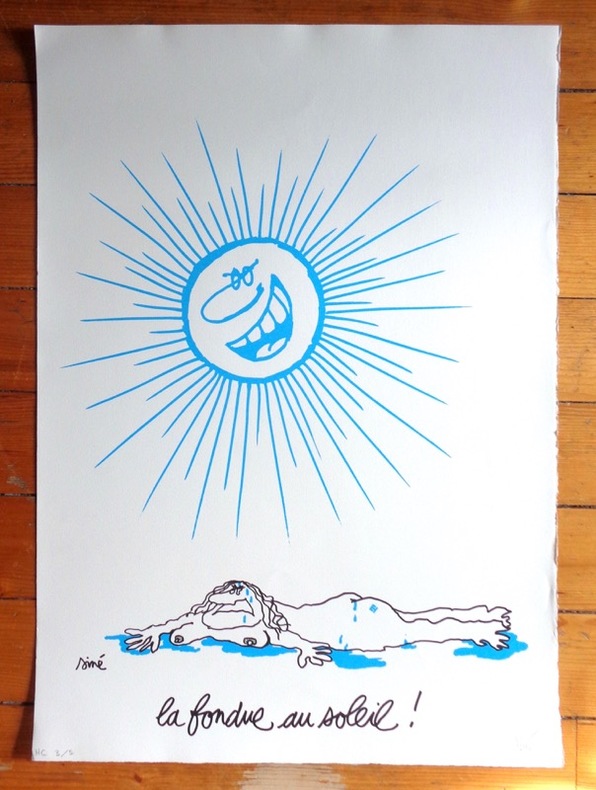
|
|
|
Singer Pat:
New York Times Square.
Reproduction au format 20,5 x 13,5, sous passe-partout biseauté et cadre noir (26 x 21 cm.).
Référence libraire : 21100
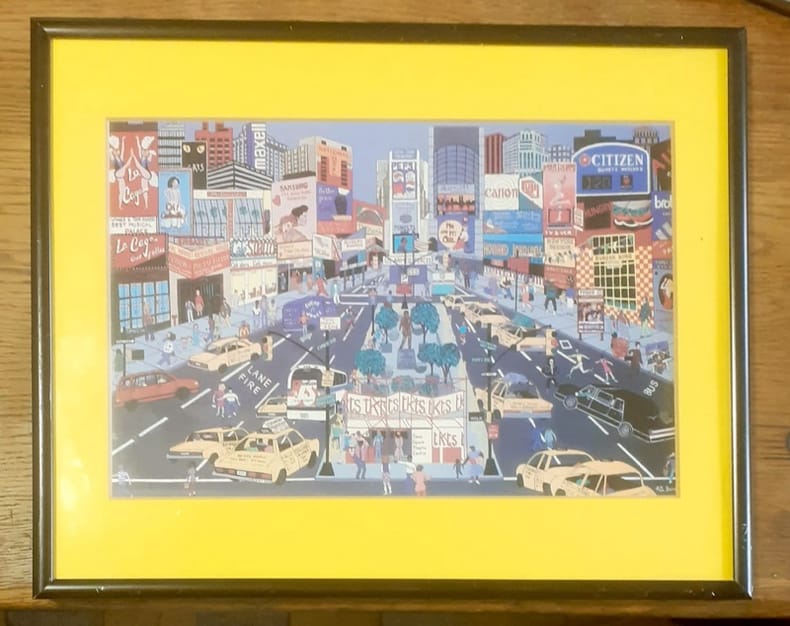
|
|
|
SINE (Maurice SINET, dit).
Pour un "véritable" équilibre sexuel... Pour la M.N.E.F. votez U.N.E.F.
1968 Grenoble, Imprimerie COOP A.G.E., s.d. (1968), 1 affiche 560 x 380 illustrée en noir avec texte en rouge sur fond blanc.Légèrement froissée, papier très légèrement jauni, très bon état par ailleurs.
Référence libraire : 12241

|
|
|
SINE (Maurice SINET, dit).
Pour enlever les patrons des leviers de commande. Pour la M.N.E.F., votez U.N.E.F. !
1968 Grenoble, Imprimerie COOP A.G.E., s.d. (1968), 1 affiche 560 x 380 illustrée en noir avec texte en rouge sur fond blanc.Légèrement froissée, papier très légèrement jauni, très bon état par ailleurs.
Référence libraire : 12246
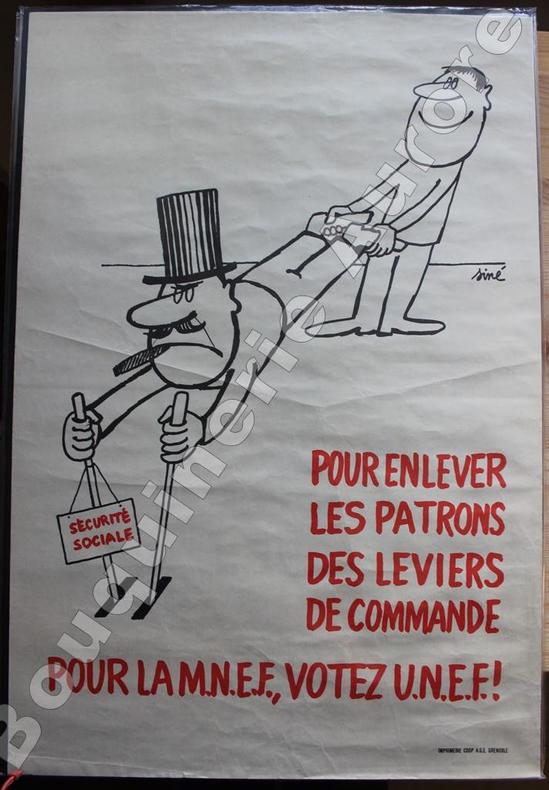
|
|
|
SINE & MATALON (Eddy).
T'inquiète pas, ça se soigne !
Affiche 52,5 x 39 cm. dessinée par Siné, pour le film T'inquiète pas, ça se soigne ! d'Eddy Matalon sorti en 1980, avec J.-M. Dupuis, B. Le Coq, Rosy Varte, H. Deschamps, etc. E.O.
Référence libraire : L8085
|
|
|
Sire Denis:
Pontiac - Glamour.
Art Moderne. Affiche au format 70 x 50 cm., avec très légers frottements en bords (voir image).
Référence libraire : 3584
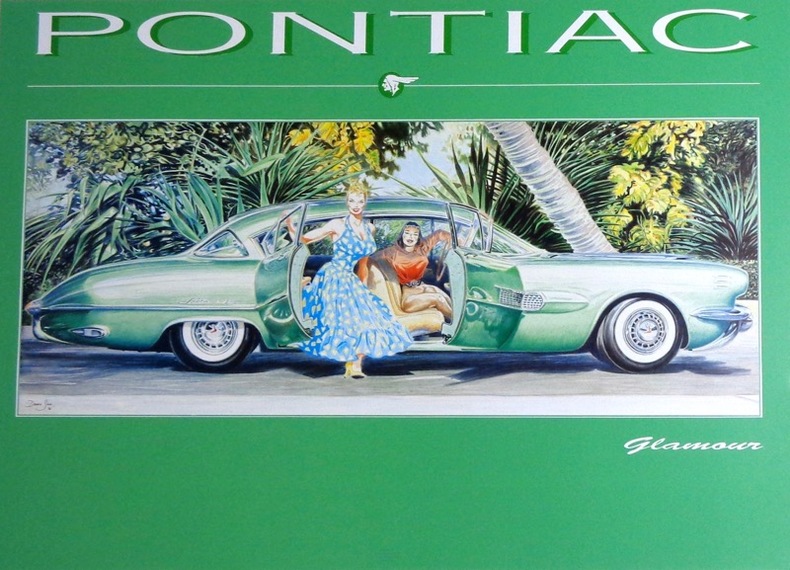
|
|
|
Sire Denis:
Texas Red.
Art Moderne. Affiche au format 50 x 70, en belle condition.
Référence libraire : 3583
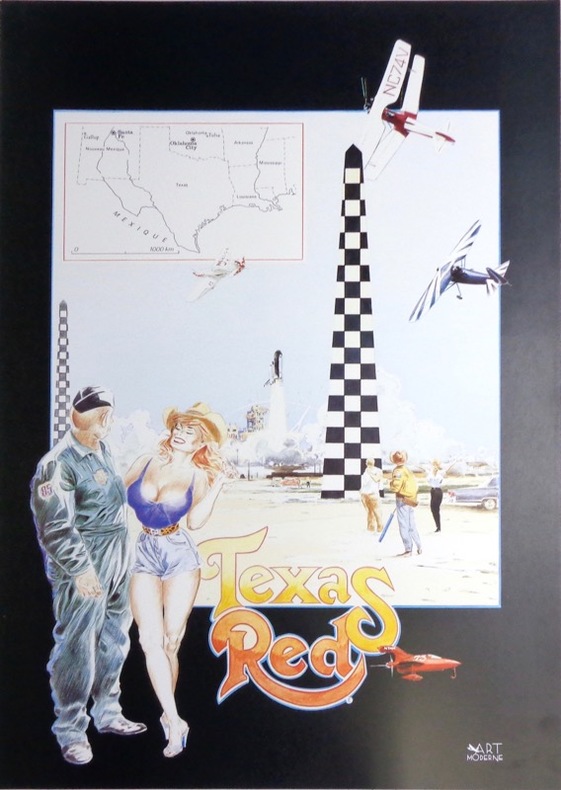
|
|
|
SISSI SPACEK - HENRI THOMAS - SAM SHEPARD
AFFICHE DE CINEMA - L'HOMME DANS L'OMBRE
JACK FISK. Non daté. In-12. Broché. Bon état, Couv. convenable, Dos satisfaisant, Intérieur frais. Affiche de cinéma 120 cm x160 cm. Une production de William D.Wittliff. - Burt Weissbourd.. . . . Classification : 0-Affiches Cinéma
Référence libraire : R100000048
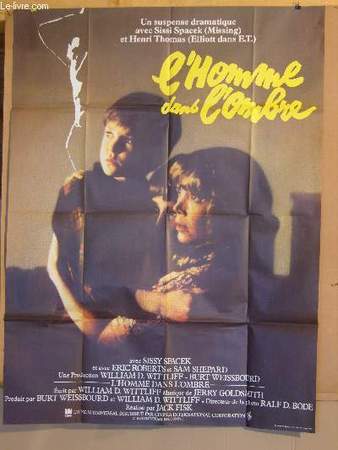
|
|
|
SITUATIONNISTES].
Misère de la révolution et révolution de la misère.
Strasbourg Sans nom, 12 décembre 1968 1968 1 vol. broché 1 feuillet dactylographié recto-verso. Tract strasbourgeois signé "Les Enragés" dénonçant la tiédeur de la dernière assemblée générale à la Faculté des Lettres.
Référence libraire : 90689
|
|
|
SITUATIONNISTES].
Misère de la révolution et révolution de la misère.
Strasbourg Sans nom, 12 décembre 1968 1968 1 vol. broché 1 feuillet dactylographié recto-verso. Tract strasbourgeois signé "Les Enragés" dénonçant la tiédeur de la dernière assemblée générale à la Faculté des Lettres.
Référence libraire : 90689
|
|
|